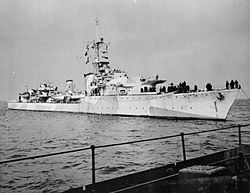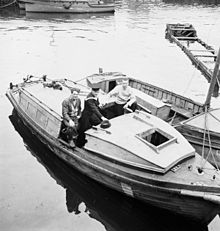HMCS Athabaskan (G07)
|
HMCS Athabaskan
|
||||||||||||||||||||||
|
||||||||||||||||||||||
|
||||||||||||||||||||||
|
||||||||||||||||||||||
|
||||||||||||||||||||||
HMCS Athabaskan (G07) was a (second) Tribal class destroyer ordered from Great Britain in April 1940. The destroyer, which was completed on February 3, 1943, sank on April 29, 1944 after torpedo hits by T 24 and T 27 in the English Channel northeast of Ouessant . 128 of 261 men were killed, 85 were rescued from German ships and taken prisoner of war; another 48 came back to England with the sister ship HMCS Haida and its cutter.
History of the Athabaskan
In 1940 the Royal Canadian Navy decided to procure seven British Tribal-class destroyers to be built in Great Britain and Canada. Four destroyers were ordered from Vickers-Armstrong's High Walker Shipyard in Newcastle , which had already built four boats for the Royal Navy. They came into service with the RCN between December 1942 and September 1943, while the ships built in Canada were only completed after the end of the war. The first two ships were to be named Iroquis and Athabaskan . Since the completion of the Iroquis was delayed by a bomb damage on the slipway , the names were changed before the launch, so that the first completed ship continued to receive the name Iroquis and the second then the name Athabaskan . The name Athabaskan refers to the Canadian natives (First Nations) who belong to the Athapaskan language family . The tribals built by Vickers-Armstrong for Canada largely corresponded to the British buildings from the 1930s. Only the heating and ventilation systems have been improved for use in the North Atlantic. The armament took up the changes made in the meantime by the British ships, so that the destroyers only received three 120 mm double armatures and a 102 mm twin gun was installed on the rear elevated position primarily for anti-aircraft defense. The position of the "pompom" quadruple was changed , which was placed a little further back and higher and had an improved fire area. There were also six 20 mm Oerlikon twin automatic cannons . The hull of the newbuildings for Canada was also somewhat wider.
Operations in World War II
HMCS Athabaskan had a relatively short period of fourteen months from commissioning to loss. During this time, the destroyer failed several times due to accidents and combat damage and was not available for another five months. After a short run-in period, the Athabaskan began operating on February 3, 1943. A deployment against blockade breakers in the sea area between Iceland and the Faroe Islands from March 29, 1943 resulted in severe marine damage, which took five weeks to repair. The destroyer was then used in Operation Gearbox III to supply the garrison on Spitsbergen . On June 18, 1943, the destroyer collided with a guard ship in Scapa Flow . The necessary repairs in Devonport took a month.
The Athabaskan then remained in Plymouth and was used from July to secure allied "support" or "escort groups" during search trips for German submarines on the march out or back in the Bay of Biscay . For this task, cruisers like the Scylla , Bermuda and Glasgow , the escort carrier Archer as well as the Canadian Iroquois and the Polish Hurricane were available as additional destroyers. At a patrol destroyers and Glasgow with the aim to detect leaking of France German ships and sink, three co-operating with the Navy Spanish trawlers were applied, one of which on 22 July by a demolition squad of the hurricane was sunk
from the 26th August the 1st Support Group with the sloops Pelican and Egret and the frigates Jed , Rother , Spey and Evenlode were in action near Cabo Ortegal . The destroyers Athabaskan and Grenville had replaced Bermuda for security . On August 28, 18 Dornier Do 217s of Kampfgeschwaders 100 attacked the Support Group with Henschel Hs 293 guided bombs . Five machines attacked the Athabaskan despite heavy defensive fire. One machine scored a hit that caused severe damage on Athabaskan and killed five men. The guided bomb penetrated the destroyer and then exploded outside the hull. Six planes attacked Grenville , which was being prepared for such an attack , which managed to avoid damage with quick evasive maneuvers, while an embarked camera team filmed the attacks. Egret tried to avoid seven missiles, but was hit by an Hs 293 in the aft ammunition area and literally tore apart (197 dead). It was the first ship to be destroyed by a powered missile after the first use of the weapon on August 25 against the previously deployed 40th Escort Group only damaged the two sloops Landguard (ex USCGC Shoshone ) and Bideford . The Athabaskan could reach Plymouth on its own.
In December, the destroyer returned to Scapa Flow to take part in securing the Northern Sea Convoy JW 55A , whose 19 transporters reached the Soviet Union undamaged because attacking submarines did not come within torpedo range of the convoy.
In February 1944 the Athabaskan moved again to Plymouth and was assigned to the newly established 10th Destroyer Flotilla . The ship was involved in operations in Operation Hostile (laying of sea mines) and Operation Tunnel (surveillance trips) off the French coast. On April 26, the destroyer was involved in a tunnel mission in association with the British cruiser Black Prince and destroyer Ashanti as well as the sister ships Haida and Huron in the sinking of the T 29 fleet torpedo boat off Ushant .
The end of the Athabaskan
In the early morning of April 29, 1944, Athabaskan secured a British mine operation off the French coast near the mouth of the Morlaix with her sister ship Haida when they received orders to intercept German surface vessels near the Île de Batz that had detected radar systems in southern England. In the following battle with the fleet torpedo boats T 24 and T 27 on her transfer march from St. Malo to Brest , the Athabaskan was torpedoed and sank at position 48 ° 43 ′ N , 4 ° 32 ′ W . T 27 has to sit on the beach after the battle with Haida . Haida rescued 42 Athabaskan men , whose commander could not be saved and tried to swim to accompany other survivors to the Haida and was then no longer found.
When the Haida withdrew from the sinking site due to the danger of German air or sea attacks when it got light, she left her motor cutter under Leading Seaman WA MacLure with three volunteers. She was able to save six survivors of the Athabaskan and two Haida men who had gone overboard while attempting to rescue their ship. Three German minesweepers who had run from the coast to the sinking site after the Haida had run down, pursued the cutter only briefly. After several engine failures and attacks by German aircraft, the cutter, accompanied by machines from the Royal Air Force , reached the English coast shortly before midnight. 85 Athabaskan men were rescued and captured by the three German minesweepers, 42 her sister ship Haida , 6 her cutter, but 128 Athabaskan men did not survive the sinking of their ship.
Typically for a night battle, even eyewitnesses provided various information about the processes. Some Athabaskan survivors said the ship was hit first by a coastal battery and then by a torpedo. The official historiography of the Royal Canadian Navy attributes the fact that after 15 minutes there was a second large explosion to the fire on board that reached the ammunition magazine, at least one survivor also reported a second torpedo hit.
In 2004, the Royal Canadian Navy had a brass plate placed on the ship's wreck to commemorate the losses. The investigation of the wreck also led to new findings, but could no longer clarify the exact reason for the loss. The wreck is very badly damaged and distributed, especially as there is a significant tidal current at the sinking site.
Honors
- Athabaskan Island , near Bella Bella off British Columbia , was named in honor of the destroyer Athabaskan .
- École John Stubbs Memorial School near Victoria, British Columbia , was named after the fallen commanding officer, Lieutenant Commander John Stubbs.
literature
- Martin H. Brice: The Tribals , Ian Allan, London (1971), ISBN 0-7110-0245-2
- Maurice Cocker: Destroyers of the Royal Navy, 1893-1981 , Ian Allan 1983, ISBN 0-7110-1075-7 .
- John English: Afridi to Nizam: British Fleet Destroyers 1937-43 , World Ship Society, Gravesend (2001), ISBN 0-905617-95-9 .
- Hans H. Hildebrand / Albert Röhr / Hans-Otto Steinmetz: The German warships: Biographies - a mirror of naval history from 1815 to the present , Koehler's publishing company, Herford, seven volumes
- Anthony Preston: Destroyers , Bison Books Ltd. 1977, ISBN 0-600-32955-0
- Jürgen Rohwer, Gerhard Hümmelchen: Chronicle of the Naval War 1939-1945 , Manfred Pawlak VerlagsGmbH, Herrsching (1968), ISBN 3-88199-009-7
- Joseph Schull: The Far Distant Ships: An official account of Canadian naval operations in World War II , Queen's Printer, Canada, Ottawa 1961,
Web links
- Athabaskan 1943 tynebuiltships, accessed on February 13, 2019
- HMCS ATHABASKAN G07 Canadian Tribal Destroyer Association, accessed on February 13, 2019
- Athabaskan (1st of the name) (G07) government website , accessed on February 13, 2019
- IROQUOIS destroyers (1942–1948) navypedia, accessed on February 13, 2019
- The Naval Service of Canada 1910-2010 The Battle of the Atlantic, 1939 to 1945 Government website, accessed on February 13, 2019
Individual evidence
- ↑ Athabaskan (1st of the name) (G07)
- ↑ Rohwer: naval warfare , 12.6.- 8.3.1943 Biscay
- ^ Rohwer: Sea War , July 19–22, 1943 Biskaya
- ↑ Rohwer: naval warfare , 23.- 29.08.1943 Biscay
- ^ Rohwer: Sea War , December 12–31, 1943 North Sea, Allied convoy operations in the North Sea.
- ↑ Schull: The Far Distant Ships , pp. 251-258.
- ↑ a b Rohwer: Sea War , April 12 - May 1, 1944 Canal
- ↑ Schull: The Far Distant Ships , pp. 256ff.
- ↑ Schull: The Far Distant Ships , pp. 253ff.
- ↑ Kettles: Last Action - HMCS Athabaskan

